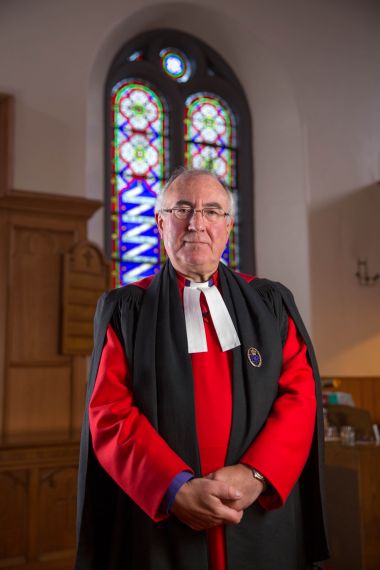A royal chaplain remembers the Queen

A former Moderator of the General Assembly of the Church of Scotland preached at Crathie Kirk in Aberdeenshire on Sunday morning as Her Majesty the Queen started her final journey.
Very Rev Dr Angus Morrison was standing in for parish minister, Rev Ken MacKenzie, who was part of the funeral cortege travelling to the Palace of Holyroodhouse in Edinburgh.
Dr Morrison is no stranger to Crathie Kirk and has preached there several times including during his Moderatorial year in 2015-16 which included a weekend stay at Balmoral Castle.
A member of the Chapel Royal, he shares his treasured memories of Her Majesty the Queen:
"I suspect like most visiting preachers, spending the weekend at Balmoral with the Queen for the first time, I was somewhat nervous in anticipation of our first meeting.
Escorted to the drawing room, I found the Queen sitting at a small table playing the game of patience.
After friendly greetings, she resumed her seat, with me sitting close by.
She continued to play as we engaged in conversation. It struck me as a very kind means of helping the visitor to relax, having us both focus on the table and cards.
As the conversation developed, the Queen gave increasingly less attention to the game and became quite animated as we spoke.
While, of course, one always remained very aware of who this extraordinary person, of such presence, was, the Queen's genuine personal interest and humanity soon dispelled any sense of nervous unease.
Not long before my first visit to Balmoral the Queen, Prince Philip and various generations of the Royal Family had been on their summer holiday, cruising around the Western Isles on board the Royal Yacht, Britannia.
Aware of my Hebridean connections, the Queen wanted to show me some holiday snaps.
These included picnics with the children on some lovely beaches.
For a few moments, you felt it could have been any devoted grandmother speaking of the fun they had.
Pointing to one little lad she said, 'If you turned your back on that rascal for an instant, you'd find him up at the top of a cliff!'
I have always felt sad about the loss to the Queen of the Britannia, knowing how very much it meant to her.
Towards the end of each season at Balmoral, it was the Queen's custom to present members of her staff there with a gift.
I was invited to accompany her to the ballroom for this special occasion.
We met first in the library where a horse race was underway on the somewhat unusual television installed there.
One of the Queen's own horses was competing and we stood in the middle of the floor, with Her Majesty clutching her handbag, for what felt like a rather long time.
The Queen's commentary as the race progressed, especially when another horse appeared to cut across hers, was interesting.
Tea was served in the ballroom and with a cup in her hand, the Queen worked one half of the room, while my job was to chat to those in the other half.
In due time, the Queen took up position by a table containing a large number of gifts for distribution.
She presented a beautifully illustrated book about British flora and fauna to all of the staff present, as they came forward one by one to receive it in person from her.
One strong impression that remains with me from that occasion was the way in which the Queen gave to each individual her full attention, as she presented their book.
Impressive, too, was the Queen's remarkable stamina, having witnessed that afternoon the apparent ease with which she could remain for a very long time on her feet.
Although considerably younger, mine had grown quite weary by the end of the afternoon!
As all visiting preachers discovered, the Queen has a deep interest in all parts of the service at Crathie Kirk and in what is said in the sermon.
During one of my visits, at the time of the war in Iraq, a number of military officers, in uniform, were sitting close to the pulpit, directly opposite the Queen.
One of them had a heavily bandaged hand, in a sling, having been wounded in action.
For the all-age talk I happened to have prepared the story of love and sacrifice involving the Dürer brothers, Albrecht and Albert, in which Albert's hands were irreparably damaged in the mines as he laboured sacrificially to support his brother during his years of study.
It is traditionally believed that a deeply grateful Albecht modelled his famous pen and ink drawing, 'Praying Hands', on those of his brother.
The Queen was quick to link the story to the situation of the injured young officer present in Crathie Kirk and was clearly very struck by the connection.
Sacrificial service was a theme close to the Queen's heart and wonderfully exemplified throughout the long years of her reign."











